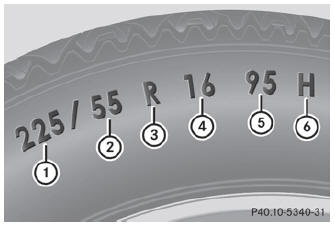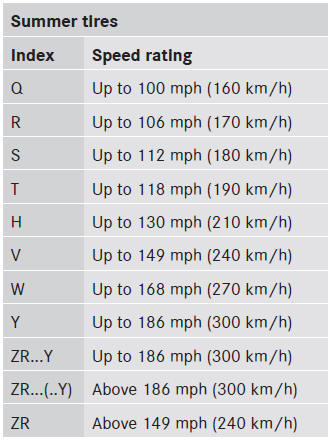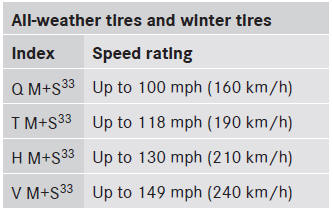Tire size designation, load-bearing capacity and speed rating

- Tire width
- Nominal aspect ratio in %
- Tire code
- im diameter
- Load bearing index
- Speed rating
![]() Tire data is vehicle-specific and may deviate from the data in the example.
Tire data is vehicle-specific and may deviate from the data in the example.
General: depending on the manufacturer's standards, the size imprinted in the tire wall may not contain any letters or may contain one letter that precedes the size description.
If there is no letter preceding the size description (as shown above): these are passenger vehicle tires according to European manufacturing standards.
If "P" precedes the size description: these are passenger vehicle tires according to U.S. manufacturing standards.
If "LT" precedes the size description: these are light truck tires according to U.S. manufacturing standards.
If "T" precedes the size description: these are compact emergency spare wheels at high tire pressure, to be used only temporarily in an emergency.
Tire width: tire width 1 shows the nominal tire width in millimeters.
Nominal aspect ratio: aspect ratio 2 is the size ratio between the tire height and the tire width and is shown in percent. The aspect ratio is calculated by dividing the tire width by the tire height.
Tire code: tire code 3 specifies the tire type. "R" represents radial tires. "D" represents diagonal tires, "B" represents diagonal radial tires.
Optionally, tires with a maximum speed of over 149 mph(240 km/h) may have "ZR" in the size description depending on the manufacturer (e.g. 245/40 ZR 18).
Rim diameter: rim diameter 4 is the diameter of the bead seat, not the diameter of the rim flange. The rim diameter is specified in inches (in).
Load bearing index: load bearing index 5 is a numerical code which specifies the maximum load-bearing capacity of a tire.
![]() WARNING
WARNING
The tire load rating must always be at least half of the GAWR of your vehicle. Otherwise, sudden tire failure may be the result which could cause an accident and/or serious injury to you or others.
Always replace rims and tires with rims and tires having the same specifications (designation, manufacturer and type) as shown on the original part.
![]() WARNING
WARNING
Do not overload the tires by exceeding the specified load limit as indicated on the Tire and Loading Information placard on the driver's door B-pillar. Overloading the tires can overheat them, possibly causing a blowout. Overloading the tires can also result in handling or steering problems, or brake failure.
Example:
The load bearing index 91 is equivalent to a maximum load of 1356 lbs (615 kg) that the tire can carry. For further information on the maximum tire load in kilograms and pounds, see ().
For further information on the load bearing index, see Load index ().
Speed rating: speed rating B specifies the approved maximum speed of the tire.
![]() WARNING
WARNING
Even when permitted by law, never operate a vehicle at speeds greater than the maximum speed rating of the tires.
Exceeding the maximum speed for which tires are rated can lead to sudden tire failure, causing loss of vehicle control and possibly resulting in an accident and/or serious personal injury and possible death, for you and for others.
Regardless of the speed rating always observe the speed limits. Drive carefully and adapt your driving style to the traffic conditions.

- Optionally, tires with a maximum speed of over 149 mph (240 km/h) may have "ZR" in the size description depending on the manufacturer (e.g. 245/40 ZR 18). The service specifications consist of load bearing index 5 and speed rating 6.
- If the size description of your tire includes "ZR" and there are no service specifications, ask the tire manufacturer in order to find out the maximum speed. If a service specification is available, the maximum speed is limited according to the speed rating in the service specification. Example: 245/40 ZR 18 97 Y. In this example, "97 Y" is the service specification. The letter "Y" represents the speed rating and the maximum speed of the tire is limited to 186 mph (300 km/h).
- Every tire that has a maximum speed above 186 mph (300 km/h) must have "ZR" in the size description and the service specification must be given in brackets. Example: 275/40 ZR 18 (99 Y). The speed rating "(Y)" shows that the maximum speed of the tire is above 186 mph (300 km/h). Ask the tire manufacturer to find out the maximum speed.

![]() Not all tires that have the M+S identification offer the driving characteristics
of winter tires. Winter tires have, in addition to the M+S identification, the
Not all tires that have the M+S identification offer the driving characteristics
of winter tires. Winter tires have, in addition to the M+S identification, the
 snow flake symbol on the tire sidewall.
Tires with this identification fulfill the requirements of the Rubber Manufacturers
Association (RMA) and the Rubber Association of Canada (RAC) regarding the tire
traction on snow and have been especially developed for driving on snow.
snow flake symbol on the tire sidewall.
Tires with this identification fulfill the requirements of the Rubber Manufacturers
Association (RMA) and the Rubber Association of Canada (RAC) regarding the tire
traction on snow and have been especially developed for driving on snow.
An electronic speed limiter prevents your vehicle from exceeding a speed of 130 mph (210 km/h).
The speed rating of tires mounted at the factory may be higher than the maximum speed that the electronic speed limiter permits.
Make sure that your tires have the required speed rating as specified in the "Tires" section (), e.g. if you buy new tires.
Further information about reading tire data can be obtained from any qualified specialist workshop, e.g. an authorized Mercedes-Benz Center.
See also:
Important safety notes
WARNING
On slippery road surfaces, never downshift in
order to obtain braking action. This could
result in drive wheel slip and reduced vehicle
control. Your vehicle's ABS will not prevent
t ...
Vehicles with a TIREFIT kit
► Lift the cargo compartment floor up.
1 Jack
2 Towing eye
3 Ratchet wrench
4 Alignment bolt
5 Fuse allocation chart
6 Folding wheel chock
7 Lug wrench ...
MOExtended tires (tires with run-flat
properties)
MOExtended tires (tires with run-flat
properties) allow you to continue driving your
vehicle even if one or more tires are entirely
deflated.
MOExtended tires may only be used in
conjunction ...
